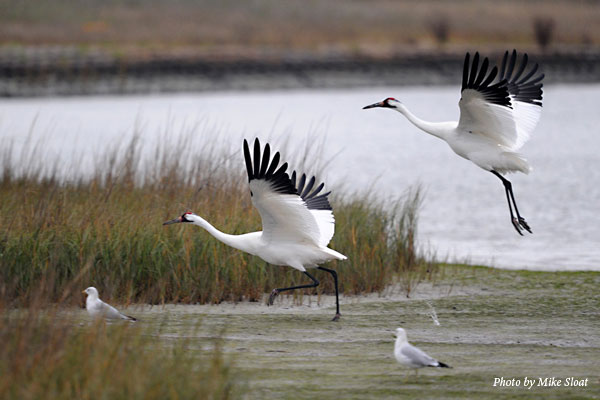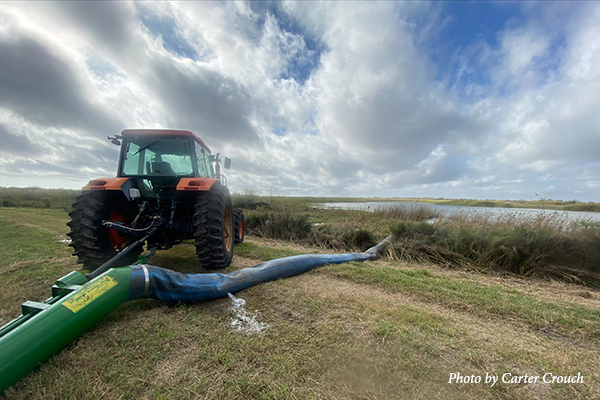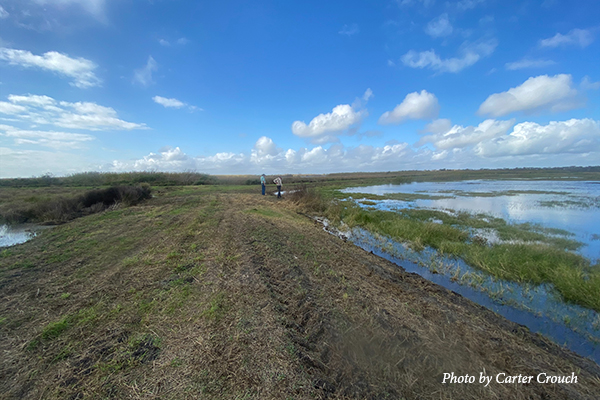
This story was originally published by Texas Water Trade on October 28, 2022. Our staff visited the Guadalupe Delta Wildlife Management Area in early December to view the revitalized wetlands as the water was pumped into the management area.
Texas Water Trade and the International Crane Foundation have finalized a water acquisition for the immediate delivery of 200 acre-feet of water to a critical bird habitat for one of the rarest and most endangered bird species in North America, Whooping Cranes.
The water will be delivered as early as this week to the Guadalupe Delta Wildlife Management Area, which is managed by the Texas Parks & Wildlife Department on San Antonio Bay, just as the Whooping Cranes are making the 2,500-mile migration south from Canada’s Wood Buffalo National Park to their wintering areas along the Texas coast. Between 500 to 600 Whooping Cranes will use this migratory flyway this fall.
The water will be delivered and held on hundreds of acres of wetlands suitable for Whooping Cranes and other threatened and endangered birds. Much of the habitat is parched today due to the state’s prolonged drought.

“The cranes are in the air flying now and when they arrive on San Antonio Bay this water will be waiting for them so they can winter there for the next five months,” said Dr. Quinn McColly, Conservation Finance Director at Texas Water Trade, noting that the birds usually arrive on the Texas coast in late October and early November.
“When conditions are dry and bay salinities go up, many of the food items that Whooping Cranes rely on decline, and the cranes spend more time in freshwater wetlands,” said Carter Crouch, Ph.D., Director of Gulf Coast Programs for the International Crane Foundation. “Right now, the bay salinity around the Whooping Crane’s primary wintering area is high, approaching ocean salinities. On top of that, many freshwater wetlands are currently dry due to this year’s drought. So, providing 100 acres of reliable freshwater wetlands near salt marsh habitat is a big win for Whooping Cranes, and I expect the more common Sandhill Cranes and other wildlife will also benefit from this freshwater habitat.”

The contract calls for the Guadalupe-Blanco River Authority to deliver 200 acre-feet of water in each of the next three years to the Guadalupe Delta WMA.
“We are excited to work with Texas Water Trade and the International Crane Foundation to manage wetlands for cranes, wading birds and waterfowl on the Guadalupe Delta WMA,” said Daniel Walker, Project Lead at the Coastal Bend Wetlands Ecosystem Project at the Texas Parks & Wildlife Department.
After facing near extinction in the 1940s, Whooping Crane populations have slowly rebounded thanks to conservation efforts to rebuild and re-establish populations across North America. Today there are two ongoing reintroduction efforts, but the Aransas-Wood Buffalo population is the only remaining self-sustaining wild population, and in the winter of 1941-1942 only 16 birds remained in this population. Today there are over 500 birds that winter on the Texas coast, but they still face many challenges.
The contract is the first of its kind in Texas to benefit Whooping Crane populations on the Texas coastline. It comes just several months after the International Crane Foundation joined Texas Water Trade’s centerpiece program, the Texas Water Market Makers, an initiative aimed at forging voluntary water transactions that will help the environment and wildlife in the state’s rivers and bays.
Similar water acquisition contracts have been negotiated by Texas Water Trade with the Galveston Bay Foundation and The Nature Conservancy for the benefit of Galveston Bay and Matagorda Bay.
